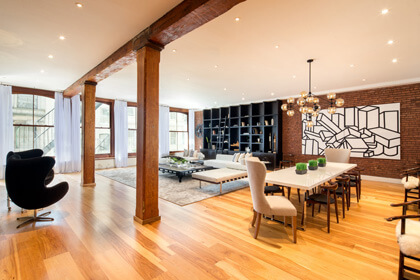Running from Canal Street south to Barclay and from Broadway to the Hudson River, Tribeca is a neighborhood of some 16,000 high-energy residents that has grown up amidst cavernous cast-iron warehouses set on historic cobblestone streets. Home seekers can find light-filled, loft-like layouts that typically fetch sky-high prices or they can look to the new luxury buildings, some with units for sale, others with rentals.
When artists in the 1970s began searching out less expensive studios and homes, the residential transformation of the neighborhood that only then came to be called Tribeca. It is now one of Manhattan’s most sought after neighborhoods.
Smart shops, art galleries, performance spaces, and prime eateries like Kutsher’s, Bouley, and Nobu are now the public face of the neighborhood, and when Lower Manhattan was staggered by the 9/11 attacks, Robert De Niro and other Hollywood bigs rallied spirits by launching the Tribeca Film Festival — though its success in recent years has led it to seek larger venues uptown.
Residential spaciousness overlays warehouse/ cobblestone historic district
Considered a quieter alternative to its equally expensive neighbor Soho, Tribeca is chock-a-block with tony shops such as the boutique retailers Steven Allen, Patron of the New, Nili Lotan, and By Joy Gryson, specialty cutlery shop Korin, and the bicyclist’s haven Adeline Adeline. Whole Foods, the Amish Market, the All Good Things artisanal market, and Grandaisy Bakery offer the very best alternatives for residents who take their cooking seriously. The Lower Manhattan locales of world-class retailers like Bloomingdales, Hermès, and Tiffany are just steps away.
The neighborhood is well served by subways, with ready access to the 1, 2, 3, A, C, and E, and another half dozen or so lines available nearby at City Hall. With Stuyvesant High School and P.S. 150 and 234 in the neighborhood, the public schools are a draw, as well.
What’s on the Market?
According MNS’s May 2014 report, Tribeca’s median purchase price per square-foot for a one-bedroom residence is $1,131. For two-bedroom units, the media price per square foot is $1,392. The same report indicates that average rents for studios in doorman buildings run at $3,400, with one-bedrooms coming in at about $4,736.
The interior of a duplex co-op at 74 Reade Street. | URBAN COMPASS
The World-Wide Group made the decision to convert 50 Murray, a 1964 office building between Church Street and West Broadway, just before 9/11. As part of the drive to revive downtown in the wake of the attack, the developers switched gears in their attention to upgrading the fixtures and finishes, and by 2002 were renting loft-like studios to three-bedroom units, ranging from about 500 to 2,000 square feet, some with outdoor space.
As a result you’ll find 11-foot beamed ceilings, kitchens with stainless steel appliances, sleek white cabinetry, black granite countertops, and two-tone penny tile mosaic bathroom floors. Residential extras include a laundry room on every floor, a bi-level roof deck, an outdoor basketball court, a lounge and screening room, a game room, playrooms, a parking garage, and doormen/concierge services. Both Equinox Gym and the Amish Market are on site, as well.
Currently, no-fee monthly rentals start at $2,900. (50murray.com)
Marketed by Corcoran Sunshine Group Marketing, the landmarked Cast Iron House at 67 Franklin Street at Broadway is a conversion developed by Knightsbridge Properties. The building has 13 duplexes, including two penthouses on newly constructed levels atop the original structure, and all sport soaring ceilings (from 17 to 25 feet), vaulted windows, washer/dryers, and quarter sawn white oak floors. Ranging from three to five bedrooms, some with outdoor space, in the original portion, square footage is from about 2,850 to 4,890. The four-bedroom penthouse is about 3,800 square feet, with some 1,530 square feet of outdoor space. The five-bedroom unit at the top is about 4,560 square feet, with rough 1,430 square feet of outdoor space.
Appliances by Gaggenau and custom lacquer cabinets topped with Corian are inside open kitchens. Marble slab master bathrooms boast white mosaic glass tile walls and radiant heat floors. Communal extras include doorman/ concierge services, a courtyard garden, an exercise room, a hydrotherapy spa and treatment room, a dance studio, a water room, a playroom, a game room, and private storage. Prices begin at about $4.97 million. (castironhouse.com)
A rental at 50 Murray, a converted 1964 office building. | WORLD-WIDE GROUP
About 3,000 square feet with key-lock elevator access, a duplex co-op at 74 Reade Street just off Church Street is now for sale through Urban Compass. In a converted office building originally erected in 1964, this flexible live/ work space’s current configuration has two bedrooms. It features double-height windows, hardwood floors, a skylight, exposed brick walls and piping, and 15-foot pressed tin ceilings. The open kitchen with a large pantry is dressed in sleek wood cabinetry and high-end stainless steel appliances. Residential extras include a roof deck and video intercom. Priced at $3.1 million. (urbancompass.com/listing/506a5c79e9e36097ea1dfe20e431ebb66068e5a7/view)































